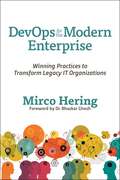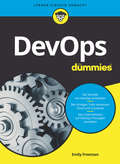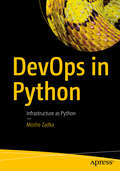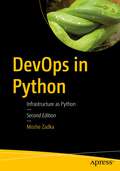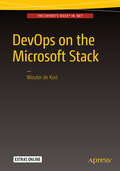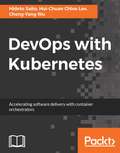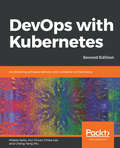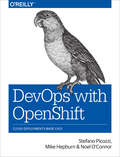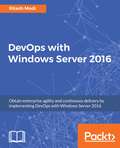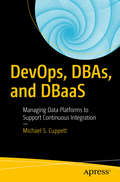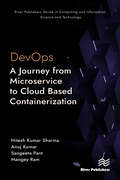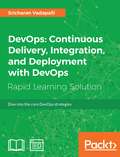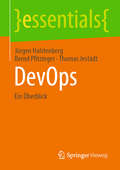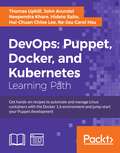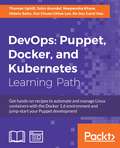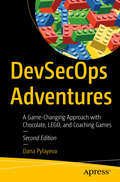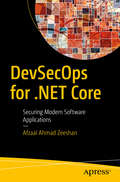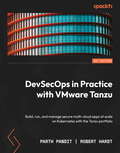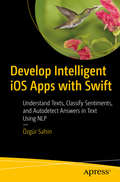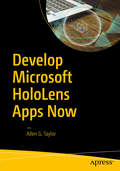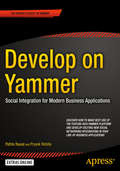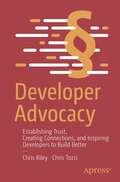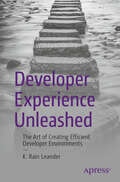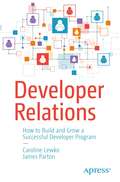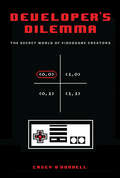- Table View
- List View
DevOps for the Modern Enterprise: Winning Practices to Transform Legacy IT Organizations
by Mirco HeringMany organizations are facing the uphill battle of modernizing their legacy IT infrastructure. Most have evolved over the years by taking lessons from traditional or legacy manufacturing: creating a production process that puts the emphasis on the process instead of the people performing the tasks, allowing the organization to treat people like resources to try to achieve high-quality outcomes. But those practices and ideas are failing modern IT, where collaboration and creativeness are required to achieve high-performing, high-quality success.Mirco Hering, a thought leader in managing IT within legacy organizations, lays out a roadmap to success for IT managers, showing them how to create the right ecosystem, how to empower people to bring their best to work every day, and how to put the right technology in the driver's seat to propel their organization to success.But just having the right methods and tools will not magically transform an organization; the cultural change that is the hardest is also the most impactful. Using principles from Agile, Lean, and DevOps as well as first-hand examples from the enterprise world, Hering addresses the different challenges that legacy organizations face as they transform into modern IT departments.
DevOps für Dummies (Für Dummies)
by Emily FreemanArbeiten auch Sie nach DevOps-Prinzipien? Sollen oder wollen Sie umstellen? Was ist wichtig? Worauf kommt es an? Das Ziel von DevOps ist, dass Softwareentwicklung und IT-Auslieferung Hand in Hand arbeiten. Das ermöglicht schnellere Release-Zyklen und schont die Ressourcen. Wie das im Einzelnen geht, zeigt dieses Buch. Es stellt eine Roadmap für die Umstellung zur Verfügung, nennt notwendige Management- und Technologie-Entscheidungen und -Tools und scheut auch nicht davor zurück, notwendige Unternehmenskulturänderungen zu benennen, damit der Sprung ins DevOps-Gewässer gelingt.
DevOps in Python: Infrastructure as Python
by Moshe ZadkaExplore and apply best practices for efficient application deployment. This book draws upon author Moshe Zadka's years of Dev Ops experience and focuses on the parts of Python, and the Python ecosystem, that are relevant for DevOps engineers. You'll start by writing command-line scripts and automating simple DevOps-style tasks. You'll then move on to more advanced cases, like using Jupyter as an auditable remote-control panel, and writing Ansible and Salt extensions. This work also covers how to use the AWS API to manage cloud infrastructure, and how to manage Python programs and environments on remote machines.Python was invented as a systems management language for distributed operating systems, which makes it an ideal tool for DevOps. Assuming a basic understanding of Python concepts, this book is perfect for engineers who want to move from operations/system administration into coding. What You'll LearnUse third party packages and create new packagesCreate operating system management and automation code in PythonWrite testable code, and testing best practicesWork with REST APIs for web clientsWho This Book Is ForJunior or intermediate sysadmin who has picked up some bash and Python basics.
DevOps in Python: Infrastructure as Python
by Moshe ZadkaTake advantage of Python to automate complex systems with readable code. This new edition will help you move from operations/system administration into easy-to-learn coding.You'll start by writing command-line scripts and automating simple DevOps-style tasks followed by creating reliable and fast unit tests designed to avoid incidents caused by buggy automation. You’ll then move on to more advanced cases, like using Jupyter as an auditable remote-control panel and writing Ansible and Salt extensions.The updated information in this book covers best practices for deploying and updating Python applications. This includes Docker, modern Python packaging, and internal Python package repositories. You'll also see how to use the AWS API, and the Kubernetes API, and how to automate Docker container image building and running. Finally, you'll work with Terraform from Python to allow more flexible templating and customization of environments.What You'll LearnUnderstand operating system automation with PythonPackage Python applicationsUse Python as a DevOps consoleReview Cloud automation with PythonWho This Book Is ForDevOps engineer. Site Reliability Engineer, or similar (including Platform, Production, and Systems), and whose organization uses Python.
DevOps on the Microsoft Stack
by Wouter De KortThis book tells you everything you need to know to help your organization implement DevOps on the Microsoft platform. You will learn how to use Visual Studio, Visual Studio Team Services, and Azure to implement a complete DevOps process in your company. You will learn about Agile Project Management, Continuous Integration, Continuous Delivery, Technical Debt Management, Automatic Testing and Monitoring, and see how all these areas fit together. DevOps is important for organizations that want to make the best use of their resources and avoid costly mistakes. Teams that embrace DevOps deploy code up to 30 times more frequently than their competition and less than 50% of their deployments fail according to Puppet Labs State of DevOps survey. DevOps on the Microsoft Stack shows you how to help your organization implement DevOps, covering the tooling they will need and how to make everything work together while following best practices. The focus is not only on technology but also on the cultural issues that teams will face when implementing DevOps. The author's goal is to not only show you which tooling there is but help you to successfully use everything together to implement DevOps in your projects and organization. What you'll learn What DevOps is and how it can help development teams How to use Visual Studio, Visual Studio Team Services, and Azure to setup a DevOps process How to introduce DevOps to your organization and how to overcome problems Who this book is for This book is for experienced developers, lead developers and architects using the Microsoft platform who are looking for ways to use Team Foundation Server and Visual Studio Online more effectively in their organization.
DevOps with Kubernetes
by Hui-Chuan Chloe Lee Hideto Saito Cheng-Yang WuLearn to implement DevOps using Docker & Kubernetes. About This Book • Learning DevOps, container, and Kubernetes within one book. • Leverage Kubernetes as a platform to deploy, scale, and run containers efficiently. • A practical guide towards container management and orchestration Who This Book Is For This book is targeted for anyone, who wants to learn containerization and clustering in a practical way using Kubernetes. No prerequisite skills required, however, essential DevOps skill and public/private Cloud knowledge will accelerate the reading speed. If you're advanced readers, you can also get a deeper understanding of all the tools and technique described in the book. What You Will Learn • Learn fundamental and advanced DevOps skills and tools • Get a comprehensive understanding for container • Learn how to move your application to container world • Learn how to manipulate your application by Kubernetes • Learn how to work with Kubernetes in popular public cloud • Improve time to market with Kubernetes and Continuous Delivery • Learn how to monitor, log, and troubleshoot your application with Kubernetes In Detail Containerization is said to be the best way to implement DevOps. Google developed Kubernetes, which orchestrates containers efficiently and is considered the frontrunner in container orchestration. Kubernetes is an orchestrator that creates and manages your containers on clusters of servers. This book will guide you from simply deploying a container to administrate a Kubernetes cluster, and then you will learn how to do monitoring, logging, and continuous deployment in DevOps. The initial stages of the book will introduce the fundamental DevOps and the concept of containers. It will move on to how to containerize applications and deploy them into. The book will then introduce networks in Kubernetes. We then move on to advanced DevOps skills such as monitoring, logging, and continuous deployment in Kubernetes. It will proceed to introduce permission control for Kubernetes resources via attribute-based access control and role-based access control. The final stage of the book will cover deploying and managing your container clusters on the popular public cloud Amazon Web Services and Google Cloud Platform. At the end of the book, other orchestration frameworks, such as Docker Swarm mode, Amazon ECS, and Apache Mesos will be discussed. Style and approach Readers will be taken through fundamental DevOps skills and Kubernetes concept and administration with detailed examples. It introduces comprehensive DevOps topics, including microservices, automation tools, containers, monitoring, logging, continuous delivery, and popular public cloud environments. At each step readers will learn how to leverage Kubernetes in their everyday lives and transform their original delivery pipeline for fast and efficient delivery.
DevOps with Kubernetes: Accelerating software delivery with container orchestrators, 2nd Edition
by Hui-Chuan Chloe Lee Hideto Saito Cheng-Yang WuLeverage the power of Kubernetes to build an efficient software delivery pipeline. Key Features Learn about DevOps, containers, and Kubernetes all within one handy book A practical guide to container management and orchestration Learn how to monitor, log, and troubleshoot your Kubernetes applications Book Description Kubernetes has been widely adopted across public clouds and on-premise data centers. As we're living in an era of microservices, knowing how to use and manage Kubernetes is an essential skill for everyone in the IT industry. This book is a guide to everything you need to know about Kubernetes—from simply deploying a container to administrating Kubernetes clusters wisely. You'll learn about DevOps fundamentals, as well as deploying a monolithic application as microservices and using Kubernetes to orchestrate them. You will then gain an insight into the Kubernetes network, extensions, authentication and authorization. With the DevOps spirit in mind, you'll learn how to allocate resources to your application and prepare to scale them efficiently. Knowing the status and activity of the application and clusters is crucial, so we'll learn about monitoring and logging in Kubernetes. Having an improved ability to observe your services means that you will be able to build a continuous delivery pipeline with confidence. At the end of the book, you'll learn how to run managed Kubernetes services on three top cloud providers: Google Cloud Platform, Amazon Web Services, and Microsoft Azure. What you will learn Learn fundamental and advanced DevOps skills and tools Get a comprehensive understanding of containers Dockerize an application Administrate and manage Kubernetes cluster Extend the cluster functionality with custom resources Understand Kubernetes network and service mesh Implement Kubernetes logging and monitoring Manage Kubernetes services in Amazon Web Services, Google Cloud Platform,and Microsoft Azure Who this book is for This book is for anyone who wants to learn containerization and clustering in a practical way using Kubernetes. No prerequisite skills are required, however, essential DevOps skill and public/private Cloud knowledge will accelerate the reading speed. If you're advanced, you can get a deeper understanding of all the tools and technique described in the book.
DevOps with OpenShift: Cloud Deployments Made Easy
by Mike Hepburn Noel O'Connor Stefano PicozziFor many organizations, a big part of DevOps’ appeal is software automation using infrastructure-as-code techniques. This book presents developers, architects, and infra-ops engineers with a more practical option. You’ll learn how a container-centric approach from OpenShift, Red Hat’s cloud-based PaaS, can help your team deliver quality software through a self-service view of IT infrastructure.Three OpenShift experts at Red Hat explain how to configure Docker application containers and the Kubernetes cluster manager with OpenShift’s developer- and operational-centric tools. Discover how this infrastructure-agnostic container management platform can help companies navigate the murky area where infrastructure-as-code ends and application automation begins.Get an application-centric view of automation—and understand why it’s importantLearn patterns and practical examples for managing continuous deployments such as rolling, A/B, blue-green, and canaryImplement continuous integration pipelines with OpenShift’s Jenkins capabilityExplore mechanisms for separating and managing configuration from static runtime softwareLearn how to use and customize OpenShift’s source-to-image capabilityDelve into management and operational considerations when working with OpenShift-based application workloadsInstall a self-contained local version of the OpenShift environment on your computer
DevOps with Windows Server 2016
by Ritesh ModiObtain enterprise agility and continuous delivery by implementing DevOps with Windows Server 2016 About This Book • This practical learning guide will improve your application lifecycle management and help you manage environments efficiently • Showcase through a sample application ways to apply DevOps principles and practices in the real world • Implement DevOps using latest technologies in Windows Server 2016 such as Windows Container, Docker, and Nano Servers Who This Book Is For This book is for .NET developers and system administrators who have a basic knowledge of Windows Server 2016 and are now eager to implement DevOps at work using Windows Server 2016. Knowledge of Powershell, Azure, and containers will help. What You Will Learn • Take a deep dive into the fundamentals, principles, and practices of DevOps • Achieve an end-to-end DevOps implementation • Execute source control management using GITHUB and VSTS vNext • Automate the provisioning and configuration of infrastructure • Build and release pipeline • Measure the success of DevOps through application instrumentation and monitoring In Detail Delivering applications swiftly is one of the major challenges faced in fast-paced business environments. Windows Server 2016 DevOps is the solution to these challenges as it helps organizations to respond faster in order to handle the competitive pressures by replacing error-prone manual tasks using automation. This book is a practical description and implementation of DevOps principles and practices using the features provided by Windows Server 2016 and VSTS vNext. It jumps straight into explaining the relevant tools and technologies needed to implement DevOps principles and practices. It implements all major DevOps practices and principles and takes readers through it from envisioning a project up to operations and further. It uses the latest and upcoming concepts and technologies from Microsoft and open source such as Docker, Windows Container, Nano Server, DSC, Pester, and VSTS vNext. By the end of this book, you will be well aware of the DevOps principles and practices and will have implemented all these principles practically for a sample application using the latest technologies on the Microsoft platform. You will be ready to start implementing DevOps within your project/engagement. Style and approach This practical, learning book is linear and progressive, and every chapters builds on the previous chapters. We focus on the practical skills required to implement DevOps, with a summary of the key concepts only where strictly necessary.
DevOps, DBAs, and DBaaS
by Michael S. CuppettLearn how DBAs in a DevOps environment manage data platforms and change requests to support and optimize continuous integration, delivery, testing, and deployment in the application development life cycle. On the Dev side, DBAs evaluate change requests to ensure compliance with organizational best practices and guard against degradation of database performance and the validity of dependent objects. On the Ops side, DBAs perform release and troubleshooting activities in support of the application, manage the data platform's access and security, and monitor and maintain performance of the databases that they have designed and provisioned. DevOps, DBAs, and DBaaS investigates the complex intersection between DBA functions and DevOps processes. DevOps teams traditionally viewed DBAs as process outliers who disrupt and retard SDLC timelines. At each touch point, veteran DBA Mike Cuppett shows how DBAs can most effectively contribute to decreasing release cycle times and improving product resiliency by applying automation, orchestration, and DBaaS solutions to database administration in ways that dovetail with DevOps requirements and metrics. At a high level, Cuppett demonstrates the importance of leveling silo walls in the IT supply chain and of measuring application performance holistically by reference to satisfaction of customer requirements and end-user experience. At a technical level, he drills into topics and case studies on diagnosing and resolving problems commonly encountered by DBAs and DevOps teams when meshing database management with application delivery. What You Will Learn: Understand techniques and best practices at all points of collaboration between DBAs and DevOps teams in product development Use tools for measuring DBA inputs to DevOps processes by using the holistic criteria of end-user experience and business requirement Integrate open source database technologies with DevOps Know when to decouple application and database layers and move to DBaaS models Overcome language and mindset barriers between DBAs and DevOps teams Who This Book Is For: DBAs who are leaning toward or already involved with DevOps and DevOps engineers, team leaders, developers and product managers who are already working with DBAs or planning to integrate DBAs in DevOps teams. The secondary readership is executives and managers in companies that practice DevOps.
DevOps: A Journey from Microservice to Cloud Based Containerization (River Publishers Series in Computing and Information Science and Technology)
by Mangey Ram Anuj Kumar Hitesh Kumar Sharma Sangeeta PantTransitioning to DevOps requires a change in culture and mindset. At its simplest, DevOps is about removing the barriers between two traditionally siloed teams, development, and operations. In some organizations, there may not even be separate development and operations teams; engineers may do both. With DevOps, the two teams work together to optimize both the productivity of developers and the reliability of operations. They strive to communicate frequently, increase efficiencies, and improve the quality of services they provide to customers. They take full ownership for their services, often beyond where their stated roles or titles have traditionally been scoped by thinking about the end customer’s needs and how they can contribute to meeting those needs. Quality assurance and security teams may also become tightly integrated within these teams. Organizations using a DevOps model, regardless of their organizational structure, have teams that view the entire development and infrastructure lifecycle as part of their responsibilities. In this book, we introduce the DevOps culture, and the tools and techniques under this technical cultural umbrella. We explain microservice, containers, Docker Container, Kubernetes, etc., and the significance of these in adopting the DevOps culture for successful software development.
DevOps: Dive into the core DevOps strategies
by Sricharan VadapalliExplore the high-in demand core DevOps strategies with powerful DevOps tools such as Ansible, Jenkins, and ChefKey Features●Get acquainted with methodologies and tools of the DevOps framework ●Perform continuous integration, delivery, deployment, and monitoring using DevOps tools●Explore popular tools such as Git, Jenkins, Maven, Gerrit, Nexus, Selenium, and so on●Embedded with assessments that will help you revise the concepts you have learned in this bookBook DescriptionDevOps is the most widely used software engineering culture and practice that aim sat software development and operation. Continuous integration is a cornerstone technique of DevOps that merges software code updates from developers into a shared central mainline.This book takes a practical approach and covers the tools and strategies of DevOps. It starts with familiarizing you with DevOps framework and then shows how toper form continuous delivery, integration, and deployment with DevOps. You will explore DevOps process maturity frameworks and progression models with checklist templates for each phase of DevOps. You will also be familiar with agile terminology, methodology, and the benefits accrued by an organization by adopting it. You will also get acquainted with popular tools such as Git, Jenkins ,Maven, Gerrit, Nexus, Selenium, and so on.You will learn configuration, automation, and the implementation of infrastructure automation (Infrastructure as Code) with tools such as Chef and Ansible.This book is ideal for engineers, architects, and developers, who wish to learn the core strategies of DevOps.What you will learn●Get familiar with life cycle models, maturity states, progression and best practices of DevOps frameworks●Learn to set up Jenkins and integrate it with Git●Know how to build jobs and perform testing with Jenkins●Implement infrastructure automation (Infrastructure as Code) with tools such as Chef and Ansible●Understand continuous monitoring process with tools such as Splunk and Nagios●Learn how Splunk improves the code qualityWho this book is forThis book is for engineers, architects, and developers, who wish to learn the core strategies of DevOps.
DevOps: Ein Überblick (essentials)
by Bernd Pfitzinger Thomas Jestädt Jürgen HalstenbergDevOps, eine Zusammensetzung aus den Begriffen Development und IT Operations, ist ein Ansatz, der in vielen Start-ups, aber auch in großen Konzernen erfolgreich ist. DevOps definiert das Zusammenspiel von IT-Entwicklung, IT-Betrieb und dem Kunden mithilfe von Kultur, Werkzeugen und Prozessen neu. Dieses essential vermittelt das Wichtigste, was man dazu wissen muss. Die Autoren sind DevOps-Master und beschäftigen sich seit vielen Jahren mit DevOps sowie der Optimierung von IT-Services.
DevOps: Puppet, Docker, and Kubernetes
by John Arundel Thomas Uphill Neependra Khare Hui-Chuan Chloe Lee Hideto SaitoGet hands-on recipes to automate and manage Linux containers with the Docker 1.6 environment and jump-start your Puppet development About This Book • Successfully deploy DevOps with proven solutions and recipes • Automate your infrastructure with Puppet and combine powerful DevOps methods • Deploy and manage highly scalable applications using Kubernetes • streamline the way you manage your applications Who This Book Is For This Learning Path is for developers, system administrators, and DevOps engineers who want to use Puppet, Docker, and Kubernetes in their development, QA, or production environments. This Learning Path assumes experience with Linux administration and requires some experience with command-line usage and basic text file editing. What You Will Learn • Discover how to build high availability Kubernetes clusters • Deal with inherent issues with container virtualization and container concepts • Create services with Docker to enable the swift development and deployment of applications • Make optimum use of Docker in a testing environment • Create efficient manifests to streamline your deployments • Automate Puppet master deployment using Git hooks, r10k, and PuppetDB In Detail With so many IT management and DevOps tools on the market, both open source and commercial, it's difficult to know where to start. DevOps is incredibly powerful when implemented correctly, and here's how to get it done.This Learning Path covers three broad areas: Puppet, Docker, and Kubernetes. This Learning Path is a large resource of recipes to ease your daily DevOps tasks. We begin with recipes that help you develop a complete and expert understanding of Puppet's latest and most advanced features. Then we provide recipes that help you efficiently work with the Docker environment. Finally, we show you how to better manage containers in different scenarios in production using Kubernetes. This course is based on these books: • Puppet Cookbook, Third Edition • Docker Cookbook • Kubernetes Cookbook Style and approach This easy-to-follow tutorial-style guide teaches you precisely how to configure complex systems in Puppet and manage your containers using Kubernetes.
DevOps: Puppet, Docker, and Kubernetes
by John Arundel Thomas Uphill Neependra Khare Hui-Chuan Chloe Lee Ke-Jou Carol Hsu Hideto Saito<P><P>Get hands-on recipes to automate and manage Linux containers with the Docker 1.6 environment and jump-start your Puppet development <P><P>About This Book <P><P>Successfully deploy DevOps with proven solutions and recipes <P><P>Automate your infrastructure with Puppet and combine powerful DevOps methods <P><P>Deploy and manage highly scalable applications using Kubernetes <P><P>streamline the way you manage your applications <P><P>Who This Book Is For <P><P>This Learning Path is for developers, system administrators, and DevOps engineers who want to use Puppet, Docker, and Kubernetes in their development, QA, or production environments. This Learning Path assumes experience with Linux administration and requires some experience with command-line usage and basic text file editing. <P><P>What You Will Learn <P><P>Discover how to build high availability Kubernetes clusters <P><P>Deal with inherent issues with container virtualization and container concepts <P><P>Create services with Docker to enable the swift development and deployment of applications <P><P>Make optimum use of Docker in a testing environment <P><P>Create efficient manifests to streamline your deployments <P><P>Automate Puppet master deployment using Git hooks, r10k, and PuppetDB <P><P>In Detail <P><P>With so many IT management and DevOps tools on the market, both open source and commercial, it's difficult to know where to start. DevOps is incredibly powerful when implemented correctly, and here's how to get it done.This Learning Path covers three broad areas: Puppet, Docker, and Kubernetes. This Learning Path is a large resource of recipes to ease your daily DevOps tasks. We begin with recipes that help you develop a complete and expert understanding of Puppet's latest and most advanced features. Then we provide recipes that help you efficiently work with the Docker environment. Finally, we show you how to better manage containers in different scenarios in production using Kubernetes.
DevSecOps Adventures: A Game-Changing Approach with Chocolate, LEGO, and Coaching Games
by Dana PylayevaDiscover a groundbreaking approach to introducing DevSecOps. DevSecOps Adventures uses three innovative games to help you to maximize engagement in your training and transform learners’ mindsets, turning even reluctant sceptics into supporters and advocates of the DevOps culture. The book’s first coaching game uses LEGO, Chocolate, and role cards to explore the roles and interdependencies of Dev, Ops, and Security. Readers will experience Aha! moments, expand their individual roles, develop T-shaped skills, and experiment with changing organizational culture. The simulations depict an end-to-end product delivery process, highlighting bottlenecks in the value delivery flow. Additionally, the book is updated with two new games, "Fear in the Workplace" and "Safety in the Workplace" which provide insights into safety culture, drawing inspiration from the works of Ron Westrum, William Kahn, Amy C. Edmondson, and Dr. David Rock. Through open conversations, participants learn to identify signs of a fear-ridden culture and apply safety-enhancing practices to foster a culture of experimentation and learning. This Second Edition is enhanced with real-life examples and includes the insights from important State of DevOps reports. The updated “Key Takeaway” chapter and the new FAQ chapter prepare trainers to deliver an impactful learning experience. It serves as a facilitation guide for gamified experiential learning, provides ideas for effective debriefing, and helps readers relate the issues highlighted in the coaching games to similar challenges they may face in their organizations. What You Will Learn: Gain fundamental understanding of DevOps, DevSecOps, and Safety Culture. Develop the capability to prepare, facilitate, and effectively debrief these coaching games with your teams. Showcase how playfulness can help teams bring down a "wall of confusion" between the different functional silos. Who This Book Is For Programmers or system admins/project managers who are new to DevOps. DevOps trainers and Agile Coaches who are interested in offering a collaborative and engaging learning experience to their teams.
DevSecOps for .NET Core: Securing Modern Software Applications
by Afzaal Ahmad ZeeshanAutomate core security tasks by embedding security controls and processes early in the DevOps workflow through DevSecOps. You will not only learn the various stages in the DevOps pipeline through examples of solutions developed and deployed using .NET Core, but also go through open source SDKs and toolkits that will help you to incorporate automation, security, and compliance. The book starts with an outline of modern software engineering principles and gives you an overview of DevOps in .NET Core. It further explains automation in DevOps for product development along with security principles to improve product quality. Next, you will learn how to improve your product quality and avoid code issues such as SQL injection prevention, cross-site scripting, and many more. Moving forward, you will go through the steps necessary to make security, compliance, audit, and UX automated to increase the efficiency of your organization. You’ll see demonstrations of the CI phase of DevOps, on-premise and hosted, along with code analysis methods to verify product quality. Finally, you will learn network security in Docker and containers followed by compliance and security standards. After reading DevSecOps for .NET Core, you will be able to understand how automation, security, and compliance works in all the stages of the DevOps pipeline while showcasing real-world examples of solutions developed and deployed using .NET Core 3. What You Will Learn Implement security for the .NET Core runtime for cross-functional workloads Work with code style and review guidelines to improve the security, performance, and maintenance of components Add to DevOps pipelines to scan code for security vulnerabilities Deploy software on a secure infrastructure, on Docker, Kubernetes, and cloud environments Who This Book Is ForSoftware engineers and developers who develop and maintain a secure code repository.
DevSecOps in Practice with VMware Tanzu: Build, run, and manage secure multi-cloud apps at scale on Kubernetes with the Tanzu portfolio
by Parth Pandit Robert HardtModernize your apps, run them in containers on Kubernetes, and understand the business value and the nitty-gritty of the VMware Tanzu portfolio with hands-on instructionsPurchase of the print or kindle book includes a free eBook in the PDF formatKey FeaturesGain insights into the key features and capabilities of distinct VMWare Tanzu productsLearn how and when to use the different Tanzu products for common day-1 and day-2 operationsModernize applications deployed on multi-cloud platforms using DevSecOps best practicesBook DescriptionAs Kubernetes (or K8s) becomes more prolific, managing large clusters at scale in a multi-cloud environment becomes more challenging – especially from a developer productivity and operational efficiency point of view. DevSecOps in Practice with VMware Tanzu addresses these challenges by automating the delivery of containerized workloads and controlling multi-cloud Kubernetes operations using Tanzu tools.This comprehensive guide begins with an overview of the VMWare Tanzu platform and discusses its tools for building useful and secure applications using the App Accelerator, Build Service, Catalog service, and API portal. Next, you'll delve into running those applications efficiently at scale with Tanzu Kubernetes Grid and Tanzu Application Platform. As you advance, you'll find out how to manage these applications, and control, observe, and connect them using Tanzu Mission Control, Tanzu Observability, and Tanzu Service Mesh. Finally, you'll explore the architecture, capabilities, features, installation, configuration, implementation, and benefits of these services with the help of examples.By the end of this VMware book, you'll have gained a thorough understanding of the VMWare Tanzu platform and be able to efficiently articulate and solve real-world business problems.What you will learnBuild apps to run as containers using predefined templatesGenerate secure container images from application source codeBuild secure open source backend services container imagesDeploy and manage a Kubernetes-based private container registryManage a multi-cloud deployable Kubernetes platformDefine a secure path to production for Kubernetes-based applicationsStreamline multi-cloud Kubernetes operations and observabilityConnect containerized apps securely using service meshWho this book is forThis book is for cloud platform engineers and DevOps engineers who want to learn about the operations of tools under the VMware Tanzu umbrella. The book also serves as a useful reference for application developers and solutions architects as well as IT leaders who want to understand how business and security outcomes can be achieved using the tools covered in this book. Prior knowledge of containers and Kubernetes will help you get the most out of this book.
Develop Intelligent iOS Apps with Swift: Understand Texts, Classify Sentiments, and Autodetect Answers in Text Using NLP
by Özgür SahinBuild smart apps capable of analyzing language and performing language-specific tasks, such as script identification, tokenization, lemmatization, part-of-speech tagging, and named entity recognition. This book will get you started in the world of building literate, language understanding apps. Cutting edge ML tools from Apple like CreateML, CoreML, and TuriCreate will become natural parts of your development toolbox as you construct intelligent, text-based apps. You'll explore a wide range of text processing topics, including reprocessing text, training custom machine learning models, converting state-of-the-art NLP models to CoreML from Keras, evaluating models, and deploying models to your iOS apps. You’ll develop sample apps to learn by doing. These include apps with functions for detecting spam SMS, extracting text with OCR, generating sentences with AI, categorizing the sentiment of text, developing intelligent apps that read text and answers questions, converting speech to text, detecting parts of speech, and identifying people, places, and organizations in text. Smart app development involves mainly teaching apps to learn and understand input without explicit prompts from their users. These apps understand what is in images, predict future behavior, and analyze texts. Thanks to natural language processing, iOS can auto-fix typos and Siri can understand what you're saying. With Apple’s own easy-to-use tool, Create ML, they’ve brought accessible ML capabilities to developers. Develop Intelligent iOS Apps with Swift will show you how to easily create text classification and numerous other kinds of models. What You'll Learn Incorporate Apple tools such as CreateML and CoreML into your Swift toolbox Convert state-of-the-art NLP models to CoreML from Keras Teach your apps to predict words while users are typing with smart auto-complete Who This Book Is For Novice developers and programmers who wish to implement natural language processing in their iOS applications and those who want to learn Apple's native ML tools.
Develop Microsoft HoloLens Apps Now
by Allen G. TaylorThis is the first book to describe the Microsoft HoloLens wearable augmented reality device and provide step-by-step instructions on how developers can use the HoloLens SDK to create Windows 10 applications that merge holographic virtual reality with the wearer's actual environment. Best-selling author Allen G. Taylor explains how to develop and deliver HoloLens applications via Microsoft's ecosystem for third party apps. Readers will also learn how HoloLens differs from other virtual and augmented reality devices and how to create compelling applications to fully utilize its capabilities. What You Will Learn: The features and capabilities of HoloLens How to build a simple Windows 10 app optimized for HoloLens The tools and resources contained in the HoloLens SDK How to build several HoloLens apps, using the SDK tools
Develop on Yammer
by Pathik Rawal Pryank RohillaDevelop on Yammer is your guide to integrating the Yammer social network with your company's application ecosystem. By developing custom apps and features on the Yammer platform, you can make your workplace more productive, encourage communication and feedback, and get your colleagues collaborating across a range of platforms, including SharePoint, ASP. NET, and Windows Phone. The book begins with an introduction to the development options available along with guidance on how to set up a Yammer developer account. You'll then take your first step in Yammer integration by building a Yammer feed into a web page or other JavaScript-based client application, before diving into app creation and management on the Yammer platform. The authors provide a deep dive into the Yammer authorization process from client-side and server-side perspectives, and you'll find out how to work closely with Yammer's data streams and its full range of development possibilities using Open Graph and Yammer's REST API. The final chapters cover how to build Yammer integration into standalone applications for SharePoint and Windows Phone 8 with Yammer SDKs. All chapters are illustrated with examples and sample code, and a case study follows the development of a workplace training application as the authors apply each technique, so you can see how to make the most of what Yammer has to offer. What you'll learn Why develop on Yammer, and what development options are available How to add a Yammer feed to an HTML-based application using Yammer Embed, to bring relevant news and discussions into the contexts where they matter How to develop custom Yammer features for your SharePoint, Office or web applications on the client side with the Yammer JavaScript SDK How to carry out secure authorization and authentication on Yammer How to use Yammer Open Graph and REST APIs to posts messages, create custom activities and get data from Yammer-integrated applications How to work with the Yammer Windows Phone 8 SDK to add Yammer functionality to a Windows Phone 8 application Who this book is for This book is targeted at developers with a background in . NET/C# development. Readers should be comfortable working with JavaScript. Software architects will also find this book valuable for planning social integration across their companies' business ecosystems. Table of Contents Chapter 1: Introduction to Yammer Development Chapter 2: Yammer Feed Integration with Yammer Embed Chapter 3: Yammer App Development Basics Chapter 4: Authenticating Your Yammer Users Chapter 5: Writing Data into Yammer with Open Graph Chapter 6: Developing Custom Integrations with the Yammer REST API Chapter 7: Build Social Apps Using Yammer's JavaScript SDK Chapter 8: Build Social Apps Using Yammer's Windows Phone 8 SDK
Developer Advocacy: Establishing Trust, Creating Connections, and Inspiring Developers to Build Better
by Chris Riley Chris TozziNo matter which point you're currently at on the developer advocacy journey – whether you've already implemented a developer advocate function or you're exploring the possibility – this book is for you. This book provides actionable guidance that business and technology leaders can use to understand the benefits of advocacy, identify what goes into the function, and learn how to maximize the success of developer advocate teams.Developer advocacy is a role that is sometimes hard to quantify and build – but you feel it when you’re missing it. Companies are struggling to solidify advocacy despite a strong desire to do so and little guidance exists for businesses seeking to build a developer advocacy program or assess its effectiveness. This book will show you how to get an advocacy program in your business: the basics of having an advocacy program, what tasks and processes need to be set up, and how to identify key stakeholders. You'll see how companies of all types that sell to or engage with technical audiences can develop a developer advocacy strategy. Specifically, you'll learn what developer advocates do, how business can start an advocacy practice in your organization and how to scale and operationalize such a practice once it is in place. The book will further explore the metrics for measuring advocacy success and ways the scale advocacy teams internally and externally. The Power of Developer Advocacy explores the exciting career path of advocacy for developers and engineers. What You Will LearnDiscover what developer advocacy isDetermine which sorts of companies need the functionUnderstand what the primary strategic considerations for developer advocacy isWho This Book is For Existing and future advocacy leaders, would-be developer advocates, developer marketers and DevRel teams and leaders
Developer Experience Unleashed: The Art of Creating Efficient Developer Environments
by K. Rain LeanderExplore the intricate world of developer experience (DevEx) and its impact on the software development process. This book delves into the critical components of DevEx, such as documentation, tooling, API design, developer support, performance, and reliability, providing actionable insights and strategies to help organizations create development environments that foster productivity, collaboration, and satisfaction among developers. The main topics you'll review include the evolution of software development methodologies, the intersection of user experience (UX) and DevEx, and an in-depth exploration of the critical components of DevEx. You'll also look at practical approaches to improving DevEx, real-world examples of organizations that have successfully transformed their developer experience, and a discussion of DevEx's future trends and challenges. These topics are crucial as the software development landscape has become increasingly complex and competitive. Developer experience is no longer a luxury but a necessity for organizations seeking to attract top talent, drive innovation, and stay ahead in the industry. As the line between UX and DevEx continues to blur, it is imperative to understand how these two aspects are intertwined and how they can synergistically contribute to the success of software projects. Moreover, these topics are particularly relevant now, as remote work and distributed teams become more commonplace, making it even more critical for organizations to provide developers with the resources, tools, and support they need to be successful. Developer Experience Unleashed will inspire you to recognize the critical role of DevEx in the software development process and to adopt best practices that foster a synergistic environment where developers and users can thrive together. What You'll Learn - The evolution of software development methodologies - Key DevEx concepts and components - Strategies for improving DevEx - The interconnected nature between DevEx and user experience - Current trends and challenges facing teams and businesses - Future trends and opportunities in DevEx Who This Book Is For Software development professionals, team leads, managers, and executives interested in understanding and improving the developer experience within their organizations.
Developer Relations: How to Build and Grow a Successful Developer Program
by Caroline Lewko James PartonIncreasingly, business leaders are either looking to start a new developer program at their company or looking to increase the impact of their existing DevRel program. In this context, software developers are finally recognized as legitimate decision makers in the technology buying process, regardless of the size of their organization. New companies are appearing with the sole purpose of making tools for developers, and even companies whose primary focus was elsewhere are waking up to the developer opportunity. Even as the need and demand for DevRel has grown, there are still re-occurring challenges for DevRel leaders. It is these challenges that this book addresses, covering all aspects of a DevRel program. It is an essential reference to professionalize the practice of developer relations by providing you with strategic, repeatable, and adoptable frameworks, processes, and tools, including developer segmentation and personas, and developer experience frameworks. In Developer Relations, you’ll find the answers to the following questions: How do we convince stakeholders to support a program?How do we go about creating a program?How do we make developers aware of our offer?How do we stand out from the crowd?How do we get developers to use our products?How do we ensure developers are successful using our products?How do we measure success?How do we maintain the support of our stakeholders? After reading this book you’ll have a clear definition of what developer relations is, the type of companies that engage in DevRel, and the scope and business models involved. What You Will Learn Discover what developer relations is and how it contributes to a company’s successLaunch a DevRel program Operate a successful program Measure the success of your programManage stakeholders Who This Book Is For Those interested in starting a new developer program or looking to increase the impact of their existing one. From executives to investors, from marketing professionals to engineers, all will find this book useful to realize the impact of developer relations.
Developer's Dilemma: The Secret World of Videogame Creators (Inside Technology)
by Casey O'DonnellAn examination of work, the organization of work, and the market forces that surround it, through the lens of the collaborative practice of game development.Rank-and-file game developers bring videogames from concept to product, and yet their work is almost invisible, hidden behind the famous names of publishers, executives, or console manufacturers. In this book, Casey O'Donnell examines the creative collaborative practice of typical game developers. His investigation of why game developers work the way they do sheds light on our understanding of work, the organization of work, and the market forces that shape (and are shaped by) media industries. O'Donnell shows that the ability to play with the underlying systems—technical, conceptual, and social—is at the core of creative and collaborative practice, which is central to the New Economy. When access to underlying systems is undermined, so too is creative collaborative process. Drawing on extensive fieldwork in game studios in the United States and India, O'Donnell stakes out new territory empirically, conceptually, and methodologically. Mimicking the structure of videogames, the book is divided into worlds, within which are levels; and each world ends with a boss fight, a “rant” about lessons learned and tools mastered. O'Donnell describes the process of videogame development from pre-production through production, considering such aspects as experimental systems, “socially mandatory” overtime, and the perpetual startup machine that exhausts young, initially enthusiastic workers. He links work practice to broader systems of publishing, manufacturing, and distribution; introduces the concept of a privileged “actor-intra-internetwork”; and describes patent and copyright enforcement by industry and the state.
